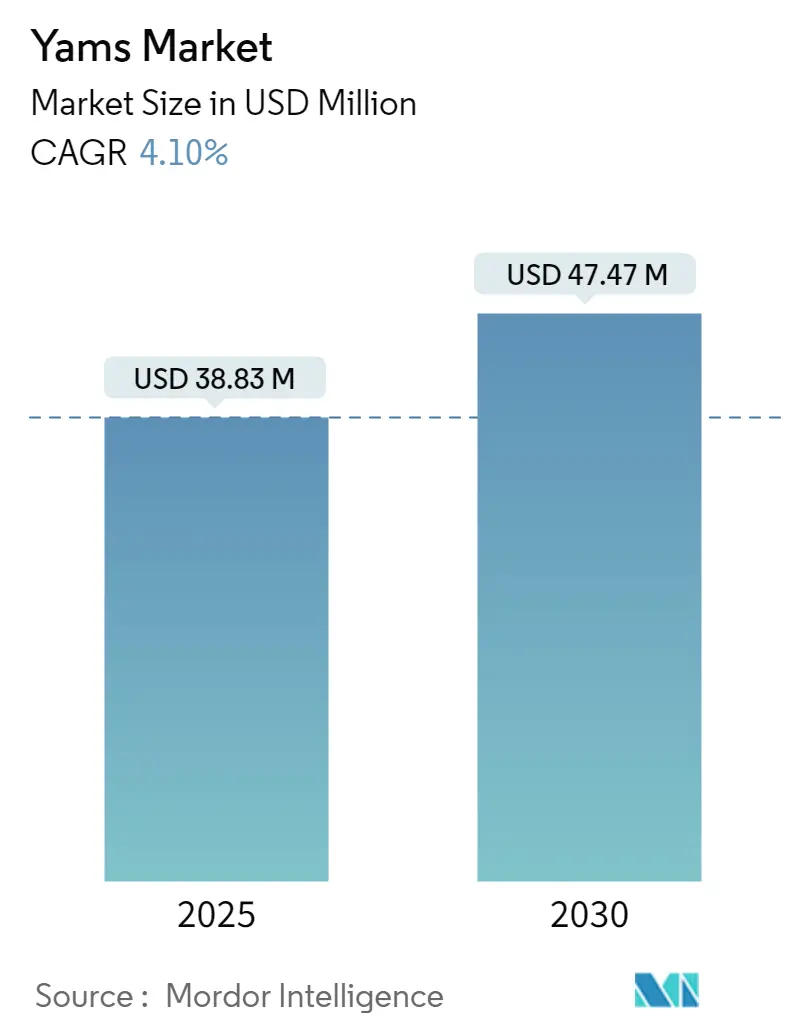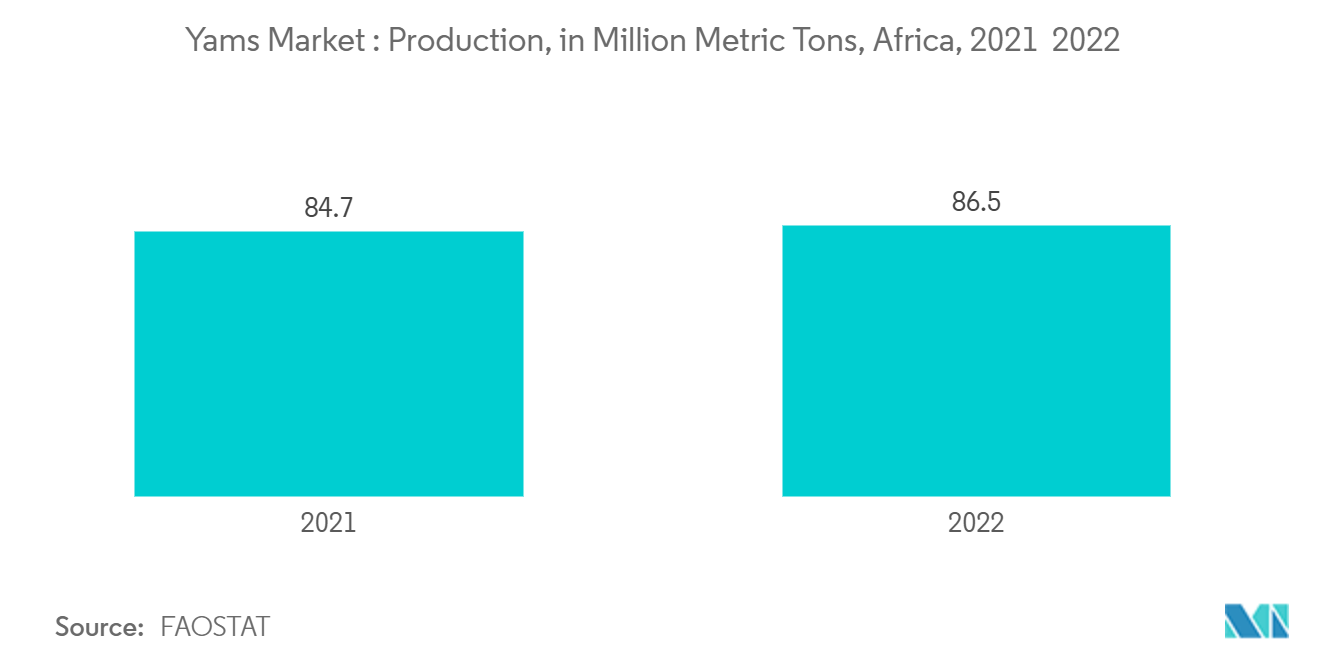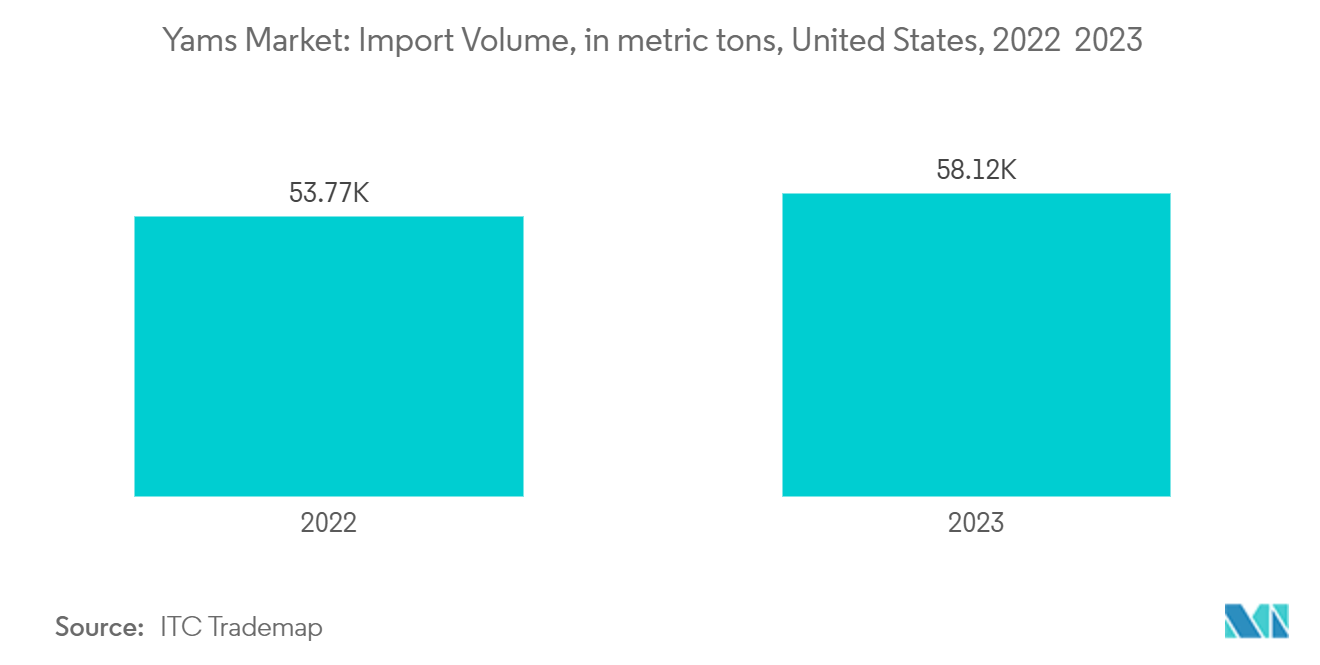
Yams Market Analysis
The Yams Market size is estimated at USD 38.83 million in 2025, and is expected to reach USD 47.47 million by 2030, at a CAGR of 4.1% during the forecast period (2025-2030).
- Yams thrive mainly in regions such as Africa, the United States, the Caribbean, the South Pacific, and Asia. The varieties include white, yellow, and purple, with cultivation adapted to regional preferences and climatic conditions. Yams are nutrient-dense, containing vitamin C, magnesium, potassium, manganese, copper, and fiber. These health benefits drive yam consumption, thereby supporting the market. Research from Yantai University in 2023 identifies yams as a source of bioactive components, with potential for developing natural compounds to prevent and treat inflammatory and metabolic diseases.
- As consumers become more aware of yams' health benefits, global demand increases, boosting production worldwide. FAOSTAT data shows yam production rose from 86 million metric tons in 2021 to 88 million metric tons in 2022. Recent advancements in production techniques also contribute to market growth. For instance, in 2021, yam farmers in Ghana's Wenchi Municipality, located in the Bono region, adopted advanced methods like trellised and ridging planting technologies to enhance their global market competitiveness. Despite high production costs, the global demand for yams remains strong, making cultivation profitable. Thus, the combination of rising production, increasing demand, and new product launches is driving market growth during the forecast period.
Yams Market Trends
Middle East and Africa leads the Production of Yams
- Africa leads the globe in yam production, with an impressive 97.4% of its yield hailing from West Africa. Within this region, Nigeria, Ghana, and Côte d'Ivoire dominate the yam landscape. In Nigeria, the size of an individual's yam holdings often serves as a marker of social status, especially during religious and communal events, further expanding the areas dedicated to yam cultivation. Data from FAOSTAT reveals that Nigeria's harvested yam area grew from 6.7 million hectares in 2019 to 7.4 million hectares in 2022. This expanding cultivation not only boosts production but also drives market growth. Moreover, the White Guinea yam, or D. rotundata, stands out as the primary yam species in Western and Central Africa, ranking as Africa's second most vital root crop after cassava.
- Agroecological zones and cultural practices post-planting play a crucial role in Nigeria's yam production. Predominantly, small-scale farmers intersperse yams with vegetables and cereals, a strategy that's significantly enhancing large-scale output. FAOSTAT data indicates a rise in regional yam production from 84.7 million metric tons in 2021 to 86.5 million metric tons in 2022, driving market growth across the continent.
- Moreover, the launch of new yam varieties promises to further energize the market. In 2024, the International Institute of Tropical Agriculture (IITA), collaborating with the Consultative Group on International Agricultural Research (CGIAR) and the National Root Crops Research Institute (NRCRI), unveiled three new yam varieties: UMUDa35-Delight, UMUDr33-Blessing, and UMUDr34-Sunshine. These are engineered to resist the yam mosaic virus and anthracnose. Thus, with Nigeria's strong production backdrop and the introduction of these innovative varieties, the market is poised for significant expansion in the coming years.

North America Dominates Import Market Share
- North America stands as the world's top importer of yams, primarily sourcing from African nations, including Jamaica, Ghana, and Costa Rica. The region's substantial immigrant populations from Africa, the Caribbean, and Latin America play a pivotal role in this trend. For these communities, yams are not just food, they're a cultural staple. Moreover, with a rising emphasis on health-conscious eating, there's an increasing appetite for foods deemed nutritious. This blend of cultural significance and health trends, fueled by the immigrant population, is propelling the yam market in North America.
- In North America, the United States and Canada dominate the yam import scene, together accounting for over 90% of the region's imports. Data from the ITC trade map highlights a consistent uptick in yam imports for both nations during the study period. Specifically, the United States yam imports rose from 53,773 metric tons in 2022 to 58,117 metric tons in 2023. In Canada, the monetary value of yam imports increased from USD 32,029 thousand in 2022 to USD 33,959 thousand in 2023. Given this momentum in both volume and value, the outlook for yam imports in North America remains bullish.
- The versatility of yams, finding their way into products like chips, ice cream, and various whole foods, is further amplifying their demand. Yet, it's worth noting that yam production within North America is quite limited. This disparity between local production and rising demand underscores the region's reliance on yam imports, a trend expected to continue in the forecast period.

Yams Market News
- September 2024: The World Iyan Carnival has been inaugurated to enhance yam production and export while celebrating Nigeria's cultural heritage. This initiative aims to address food security challenges in Nigeria and throughout Africa by actively involving stakeholders from the food and processing sectors.
- July 2024: The Ripple Effect Arts launched a new product called Organic Wild Yam Cream. The product is known for its anti-inflammatory and anti-ageing properties and is free from harmful chemicals.
- January 2024: the International Institute of Tropical Agriculture (IITA), in partnership with the Consultative Group on International Agricultural Research (CGIAR) and the National Root Crops Research Institute (NRCRI), unveiled a new yam variety named UMUDr36, branded as SharpSharp, specifically for Nigerian farmers.
Yams Industry Segmentation
Yams are perennial herbaceous vines cultivated for the consumption of their starchy tubers. The Yams market is segmented by geography into North America, Europe, Asia-Pacific, South America, and the Middle East and Africa. The report offers an analysis of production (volume), consumption (value and volume), import (value and volume), export (value and volume), and price trend analysis. The report offers market size and forecasts in terms of value (USD ) and volume (metric tons) for all the above segments.
| Geography | North America | United States | |
| Canada | |||
| Mexico | |||
| Rest of North America | |||
| Europe | Germany | ||
| United Kingdom | |||
| France | |||
| Russia | |||
| Spain | |||
| Rest of Europe | |||
| Asia Pacific | India | ||
| China | |||
| Japan | |||
| Rest of Asia Pacific | |||
| South America | Brazil | ||
| Argentina | |||
| Rest of South America | |||
| Middle East and Africa | Nigeria | ||
| Ghana | |||
| Rest of Middle East and Africa | |||
Yams Market Research FAQs
How big is the Yams Market?
The Yams Market size is expected to reach USD 38.83 million in 2025 and grow at a CAGR of 4.10% to reach USD 47.47 million by 2030.
What is the current Yams Market size?
In 2025, the Yams Market size is expected to reach USD 38.83 million.
Which is the fastest growing region in Yams Market?
South America is estimated to grow at the highest CAGR over the forecast period (2025-2030).
Which region has the biggest share in Yams Market?
In 2025, the Africa accounts for the largest market share in Yams Market.
What years does this Yams Market cover, and what was the market size in 2024?
In 2024, the Yams Market size was estimated at USD 37.24 million. The report covers the Yams Market historical market size for years: 2019, 2020, 2021, 2022, 2023 and 2024. The report also forecasts the Yams Market size for years: 2025, 2026, 2027, 2028, 2029 and 2030.
Our Best Selling Reports
Yams Industry Report
Statistics for the 2025 Yams market share, size and revenue growth rate, created by Mordor Intelligence™ Industry Reports. Yams analysis includes a market forecast outlook for 2025 to 2030 and historical overview. Get a sample of this industry analysis as a free report PDF download.


